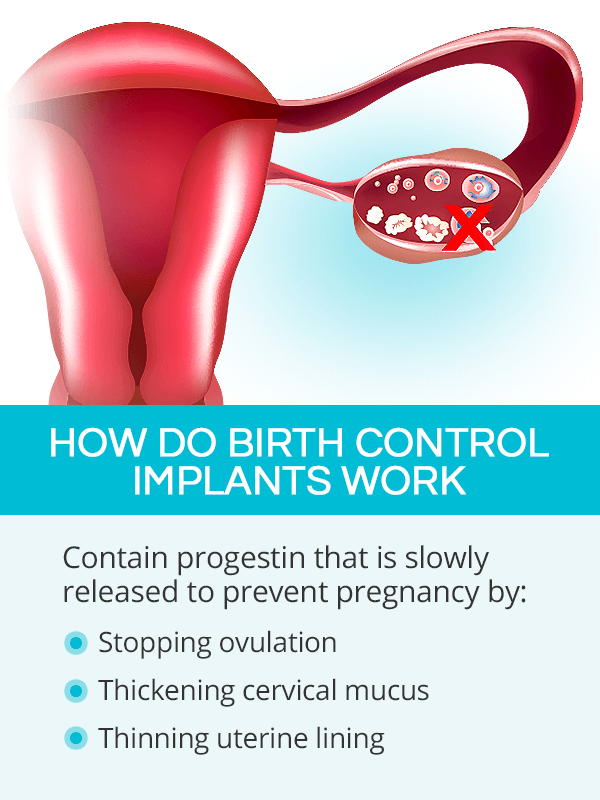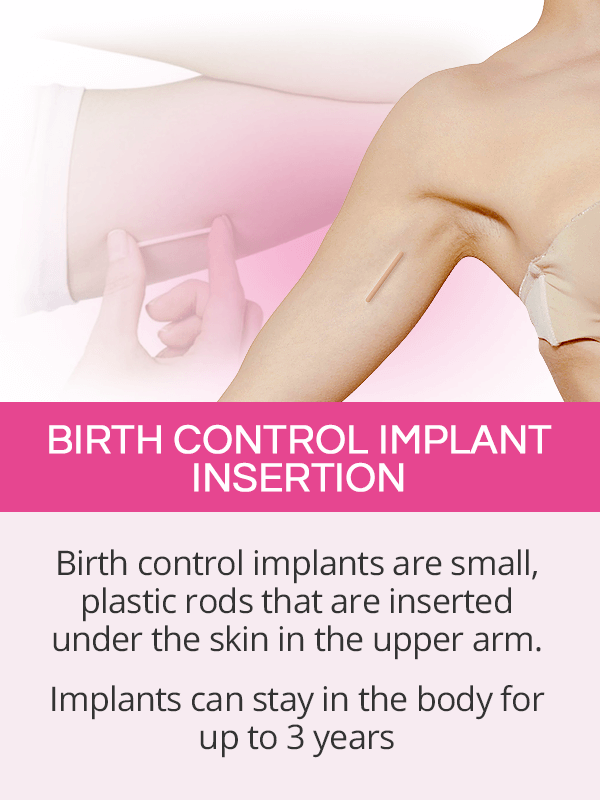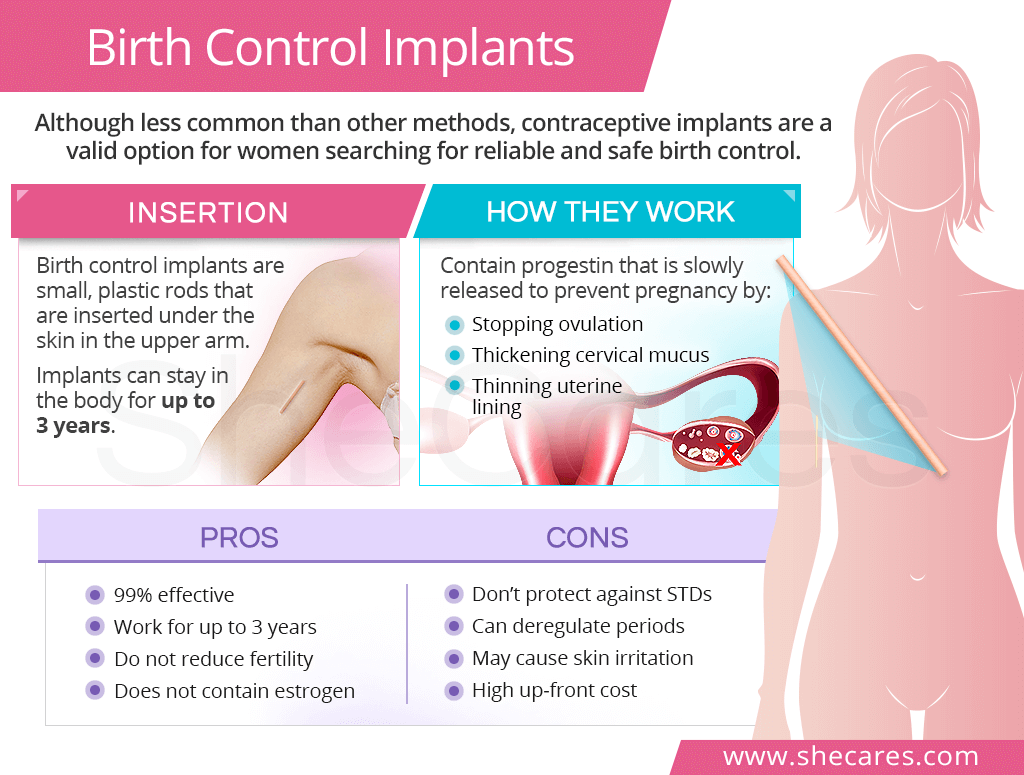About Birth Control Implants
Birth control implants are a type of long-acting, reversible contraceptive (LARC) method. Sometimes they are referred to as implantable contraception.
A hormonal implant is a small, flexible plastic rod that is inserted in the skin in the upper arm. It is about the size of a matchstick. It can stay in the body for up to three years.
To date, there is only one brand of birth control implants allowed on the US market, called Nexplanon®. It has been updated to be radio-opaque, which means it can be located on X-ray.
How Does a Birth Control Implant Work?

A birth control implant contains a progestin hormone called etonogestrel, which is a synthetic form of progesterone. Once slowly released in the blood in small doses, the hormone prevents pregnancy through the following three actions:
- It prevents ovulation from taking place, without which getting pregnant is impossible.
- It thickens cervical mucus to prevent sperm from traveling up the reproductive tract to fertilize the egg.
- It thins the uterine lining, making it difficult for the egg to implant in the uterus.
It may take about a week for an implant to begin working. As such, if it is inserted after more than five days after a woman's period, it is recommended to use a back-up birth control method for seven days.2
Birth Control Implant Insertion

A birth control implant insertion is done through a minor surgical procedure and takes a few minutes. First, a local anesthesia is applied to the arm. Then, a doctor makes a small incision in the skin and gently inserts the implant right beneath the skin.
At which point during the menstrual cycle can an implant be inserted will be determined by a doctor on an individual basis. As mentioned above, it may require back-up contraception if the insertion takes place during the fertile days of the cycle.
While the tube contains enough hormones to last for up to three years, it can be removed sooner as a woman wishes or due to a medical necessity. Some women may take a pregnancy test to ensure they are not pregnant before insertion.
Pros and Cons of Birth Control Implants

There is a reason why millions of women around the world rely on implantable contraception: it is highly effective and convenient. However, as most birth control methods, it does involve several disadvantages that should be taken into account.
Pros of Birth Control Implants
- Hormonal implants offer long-term protection since they can stay inserted for up to 3 years.
- Implants are more than 99% effective during the first year. In fact, they are said to have a 0.05% failure rate.1
- They can be inserted immediately after birth and during breastfeeding.3
- Since implants do not contain estrogen, they can be used by women who cannot take estrogen for various health risks.
- Contraceptive implants do not hinder fertility as ovulation typically returns within a few weeks after their removal.4
Cons of Birth Control Implants
- Implants do not protect from sexually transmitted diseases (STDs).
- They may cause irregular periods, including absent periods, heavy flow or scanty periods.
- Certain medications and herbal supplements may affect the effectiveness of birth control implants.
- Some women may experience irritation or infection at the site of insertion.
- The implants must be inserted at the doctor's office, thus increasing the up-front cost.
- Depending on individual insurance policy, birth control implants can cost up to $1,300.5
Key Takeaways
Alongside an IUD, birth control implants have proven to be two of the most effective reversible methods of preventing pregnancy. These small, plastic rods contain enough hormones to last for up to three years and prevent pregnancy by stopping ovulation, fertilization, and implantation. Besides its effectiveness, implantable contraception is also praised for being a convenient and long-lasting method. Since it does not contain estrogen, it can be used by women with certain restrictions. However, it also has some disadvantages worth considering, including no protection from STDs, high up-front costs, and possible menstrual irregularities as a side effect. Nevertheless, they have proven to be a valid option to consider.
Sources
- CDC. (2020). Contraception. Retrieved August 25, 2020 from https://www.cdc.gov/reproductivehealth/contraception/index.htm
- FDA. (2020). Birth Control. Retrieved August 25, 2020 from https://www.fda.gov/consumers/free-publications-women/birth-control
- Medline Plus. (2020). Birth Control. Retrieved August 25, 2020 from https://medlineplus.gov/birthcontrol.html
- National Women's Health Network. (n.d.). Birth Control Implant.Retrieved August 25, 2020 from https://www.nwhn.org/birth-control-implant-different-iud/
- Office on Women's Health. (2017). Birth control methods. Retrieved August 25, 2020 from https://www.womenshealth.gov/a-z-topics/birth-control-methods
- Planned Parenthood. (n.d.). Birth Control Implant. Retrieved August 25, 2020 from https://www.plannedparenthood.org/learn/birth-control/birth-control-implant-nexplanon
- University of Michigan. (2019). Birth Control Hormones: The Implant. Retrieved August 25, 2020 from https://www.uofmhealth.org/health-library/abq1373
Footnotes:
- Kaiser Family Foundation. (2019). Contraceptive implants. Retrieved August 25, 2020 from https://www.kff.org/womens-health-policy/fact-sheet/contraceptive-implants/
- Mayo Clinic. (2019). Contraceptive implant. Retrieved August 25, 2020 from https://www.mayoclinic.org/tests-procedures/contraceptive-implant/about/pac-20393619
- CDC. (2017). Implants. Retrieved August 25, 2020 from https://www.cdc.gov/reproductivehealth/contraception/mmwr/spr/implants.html
- Medline Plus. (2020). Birth control-slow release methods. Retrieved August 25, 2020 from https://medlineplus.gov/ency/article/007555.htm
- Planned Parenthood. (n.d.). Birth Control Implant. Retrieved August 25, 2020 from https://www.plannedparenthood.org/learn/birth-control/birth-control-implant-nexplanon
